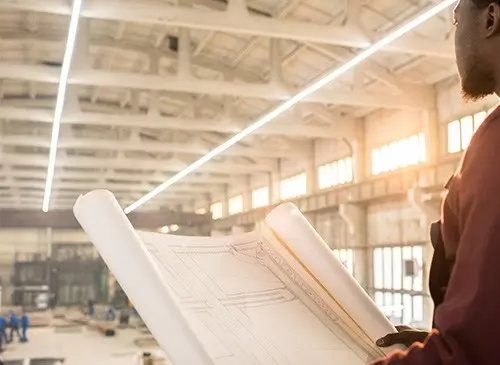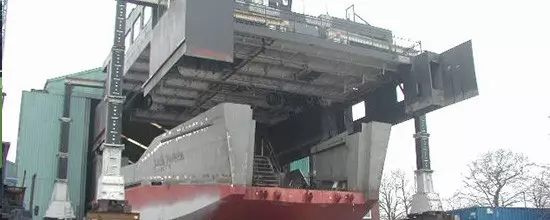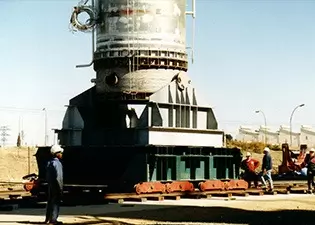How to Plan Your Plant Relocation
Each facility or plant relocation project has unique challenges. Planning and communication are the keys to success, whatever the level of industrial plant relocation or the challenges involved to ensure all is in working order.
It's not unusual for the planning and preparation process to take longer than the physical facility or plant relocation, and it is always time well spent.
1) Layouts
It is always helpful to have detailed and accurate drawings and digital photographs of your current old facility and your new facility location and placings; these need to show where your equipment is located and be checked physically against the location itself.
Accuracy is essential for a seamless and smooth lifting process as there can be many 'pitfalls' to slowing down the operations. The kind of detail that needs to be confirmed will be:
- Utility locations
- Work pits
- Equipment quantities
- Equipment asset identification numbers and sizes
- Building column locations
- Finally, one that is always missed off is what is overhead equipment - electrical wiring, overhead gantries, rigging and lighting.

Arriving on-site to a relocation plan that hasn't been carefully planned can slow things down. For example, finding a water pipe runs through the planned route and 1.5m below the top of machinery. In doing so, you can add extra expenses, a higher level of stress, and delay your entire operation.
2) Equipment Condition Review
Before your detailed plant relocation, you should have equipment reviews and a condition assessment of the machines and the vehicles you're planning to transport them in. The engineering employees and support resources should provide recommendations for whether the condition of the equipment warrants refurbishment, abandonment or direct relocation.
It is important to note that repairs, relocation, and equipment upgrades are in poor condition, as they are sometimes more expensive than replacements. For every machine that your employees and engineers will move, you will need to do the following:
- Gather and identify maintenance records
- Operation and maintenance manuals
- Spare parts inventory
- PLC and Motor plate data
- Structural information

3) As-built conditions
You will need to develop as-built equipment layout drawings, especially if your new layout drawing is non-existent. The as-built drawing must clearly show the critical utility connections, building column grid and the slated equipment that needs relocating. You should make sure the identification of equipment includes:
- Equipment type
- Manufacturer
- Motor plate number
- Weight and utility requirements
- Department or area
- Equipment identification number
We also recommend that you check state permit requirements.
Alternatively to drawings, high-resolution photographs can be used to help you document details of equipment. The photographs need to show the equipment from all sides, utility connection points and external control panels. It is vital to assess if the equipment needs unique pits, trenches and foundations. You need to provide accurate pit dimensions, for instance, depth, length, width and any utilities available.
4) Equipment database
All information gathered about the equipment should be added to a database. You should identify equipment with an ID that can be easily read or manually tagged.
The relocation contractor should document all the connections and controls tie points during the equipment relocation.

5) Schedule
The development of a relocation plan is the most critical and challenging aspect of relocating a plant. Your schedule should indicate the time that production at the current facility stops. It should also indicate the same for the new facility, this should be provided to employees and customers to allow for adjustments with ordering etc.
The plant engineer must develop steps and a schedule of relocation and removal. The design team of the facilities will require this information to schedule the design, procurement and installation of utilities and requirements of the structure. The schedule ought to include duration, testing and commissioning requirements. It would be best to have project scheduling software to track detailed schedules. We also recommend drawing up a factory relocation checklist to avoid missing any aspect.

6) Installation Coordination
The plant engineer's responsibility is to coordinate with the relocation contractor and utility installer. Such is to ensure the equipment arriving is set for installation and the tie points of a utility are available and correct.
Upon connection of equipment and utilities, the relocation contractor should perform a preliminary test. The motor rotations must be correct, the utilities must be powered, and the equipment is functioning well. If all is well, the equipment is to be mechanically complete.
7) Testing and Commissioning
The requirements for testing and commissioning are unique in each company. The plant engineer and manufacturing organisation should agree and define the amount of engineering involved with testing. The testing and commissioning requirements should outline in the ERWI if the relocation contractor is tasked to offer support. It is no small endeavour to relocate a manufacturing facility. The successful execution of the project will be down to good communication, thoughtful planning and accurate documentation.
Planning For Plant Relocation
Developing an overarching project plan is paramount, including a detailed blueprint of the overall layout and a thorough risk assessment as part of your new plant's relocation process. Many find that this is the most complex part of the moving process, and those that gloss over or skip this part often struggle with good factory or shop movements.
For those relocating from one facility to an entirely new one, you'll require an efficient plan that will allow you to ramp down production whilst transferring industrial equipment and ramping up the productivity at your new factory or store location. There are some reasons why this is so important to do so:

Proper Infrastructure
You'll discover that several of your heaviest machines and equipment will need unique pits, trenches or foundations to provide the ideal support to get your equipment across to the new place without obstructing it in any way. Ensuring you employ and attach the proper infrastructure will allow your machinery to withstand any vibration on the road and during any travel. You want to be sure to factor in construction time if any of your machinery requires rebuilding before being brought into the new building.

Qualified Professionals
Another essential requirement of any industrial move is searching for a completely qualified and experienced industrial rigger. Moving the equipment and machinery is a job for those with specialised knowledge and top-quality equipment and mechanisms to assist you; Projector Lifting Service Ltd has precisely that! Our staff understand, and we'll take the safety of you and your employees seriously throughout.
There are also many reasons your business may want to relocate your store or factory:
Perhaps you are consolidating operation, downsizing, or expanding your brand or supply chain. Companies worldwide have found that the pandemic has caused them to expand or downsize their business.
Another reason you might be relocating is to be closer to new suppliers or new customers that you have garnered over time.
You may not have the infrastructure to support the demand you currently acquire.
Whatever the reason, Our services are always available to help you with your move. Contact us today on our phone number or email address for a free quote, and we'll discuss how best to streamline your successful relocation process.
Our talented professionals and contractors will help you curate a well-laid overall plan to have you set up in your new building or factory.
How To Streamline Industrial Relocation
Our Projector Lifting Service Ltd team has years of experience in consulting and factory relocation, with excellent tradespeople and workers on board to help you complete moving tasks.
Each move is different, as there are many aspects to consider, including the size of the existing application and the new one, the number of equipment and machinery that workers must move, the chosen route, and the amount of staff on board. However, each consideration is something these relocations have in common; all have potential challenges that you must prepare to overcome.
You'll want to employ professional industrial machinery movers that will successfully help you plan and perform all the heavy work safely and efficiently. With the help of our trained professionals, your company will complete your relocation with ease and will return to productivity.
Projector Lifting Service Ltd created this guide to help you plan your manufacturing plant's relocation. We have over 159 years of experience in heavy machinery lifting and relocation. Our services can help you plan your plant and machinery's safe and efficient moving.
Our range of lifting equipment and experience means that we can move anything from transformers, generators and injection moulding machinery to Euro shuttle and Crematoria.
Contact us with the details below to get a quotation for heavy lifting between 20-453 Tonnes or a bespoke contract lifting service. We treat each customer the same whether a big or small job, so why wait.
